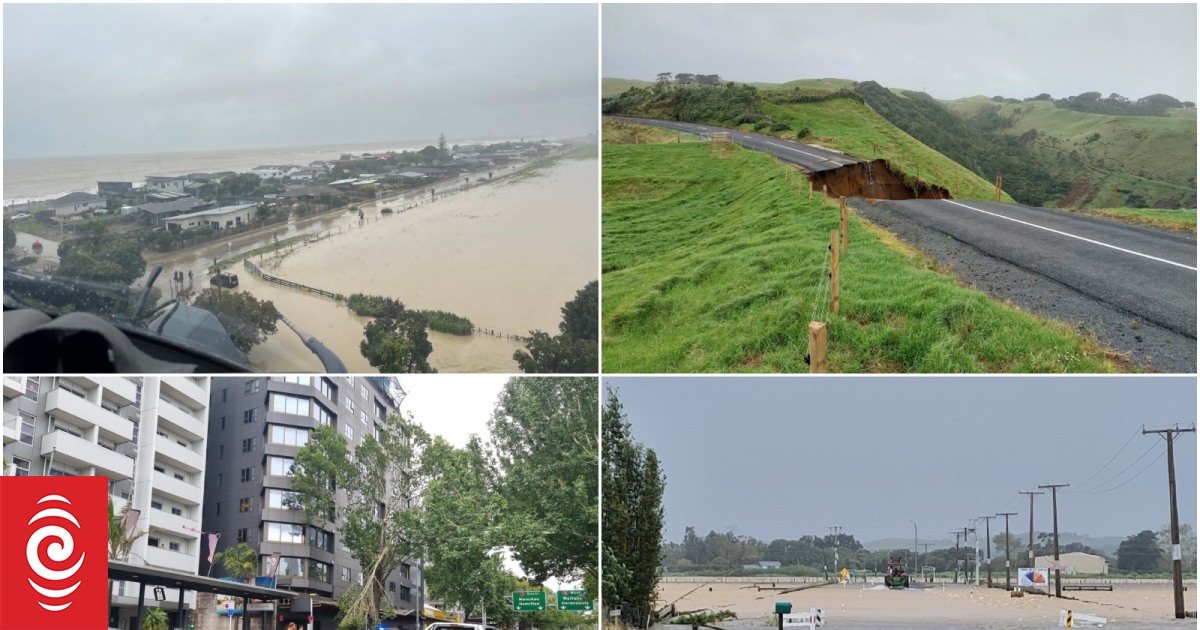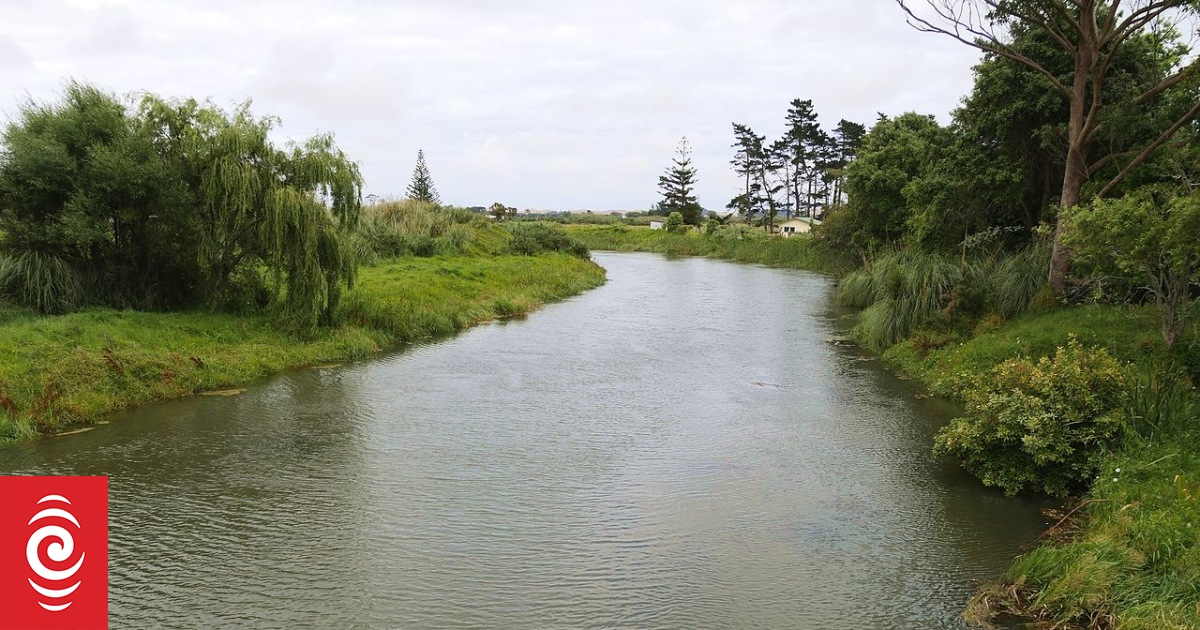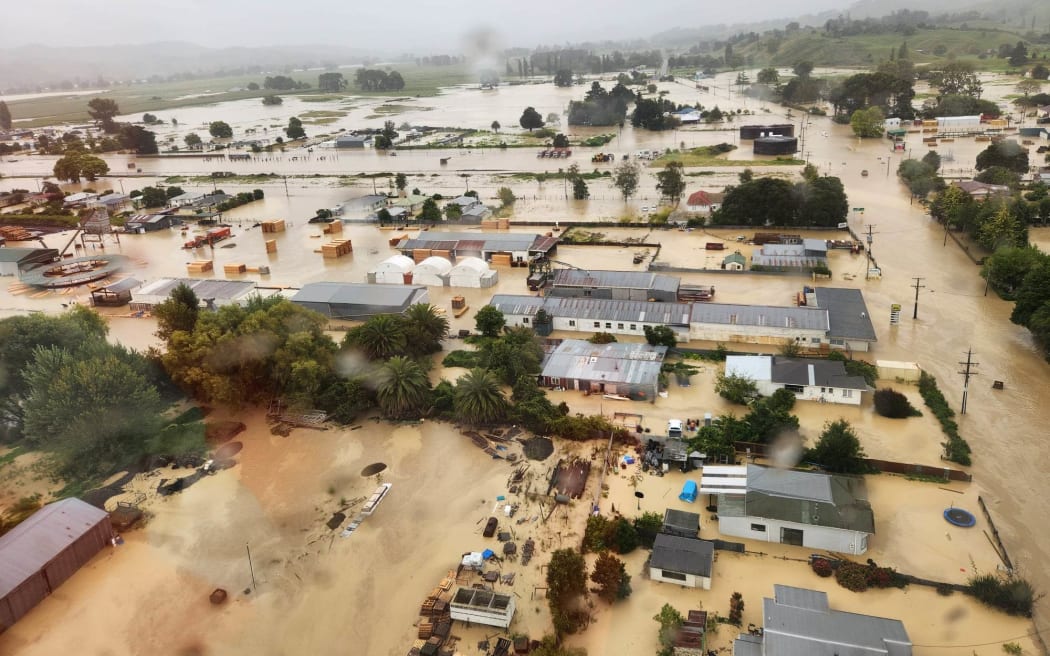
Wairoa in northern Hawke’s Bay after the Wairoa River burst its banks.
Photo: Hawke’s Bay Civil Defence Emergency Management Group
Cyclone Gabrielle has severely impacted electricity supply and communications in parts of the North Island as it now heads southeast.
Here’s what you need to know about how the situation is unfolding in your region.
Northland
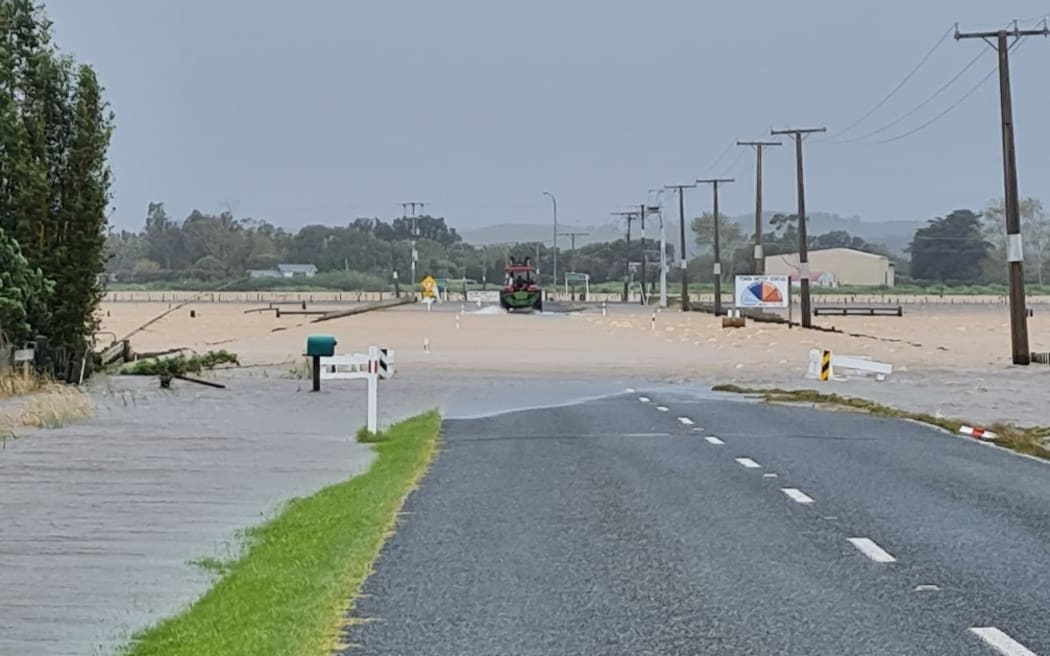
The road from Baylys Beach to Dargaville in Northland flooded yesterday.
Photo: RNZ/ Mick Hall
Whangārei residents are re-emerging from their homes and businesses are re-opening as the city sees its first blue skies in almost a week.
Some showers were still expected, but Northland’s high wind and heavy rain warnings had been removed.
Mayor Vince Cocurullo said there were still several areas without power, including about 18,000 Northpower customers.
He said the roads were not looking good, with a number of damaged areas, including major state highways.
Cocurullo said people in the Whangārei Heads Area would need to conserve water as the main pipeline had been broken by a slip.
Meanwhile in Dargaville, hundreds of people had been evacuated after the Awakino River burst its banks, forcing 160 people to sleep in evacuation centres on Tuesday night.
Kaipara District Council Mayor Craig Jepson believed the worst of the cyclone’s impact was over for Dargaville, apart from an upcoming high tide.
Jepson told RNZ’s Morning Report it would be a critical moment for the town when the tide comes around, because it would affect the water levels.
He said people who needed to be evacuated had been and they were likely to be kept in evacuation centres for some time.
“There’s so much damage on the roads with fallen trees and swollen waterways, we’re encouraging people not to go back too early,” he said.
“The community have looked after each other well.”
Auckland
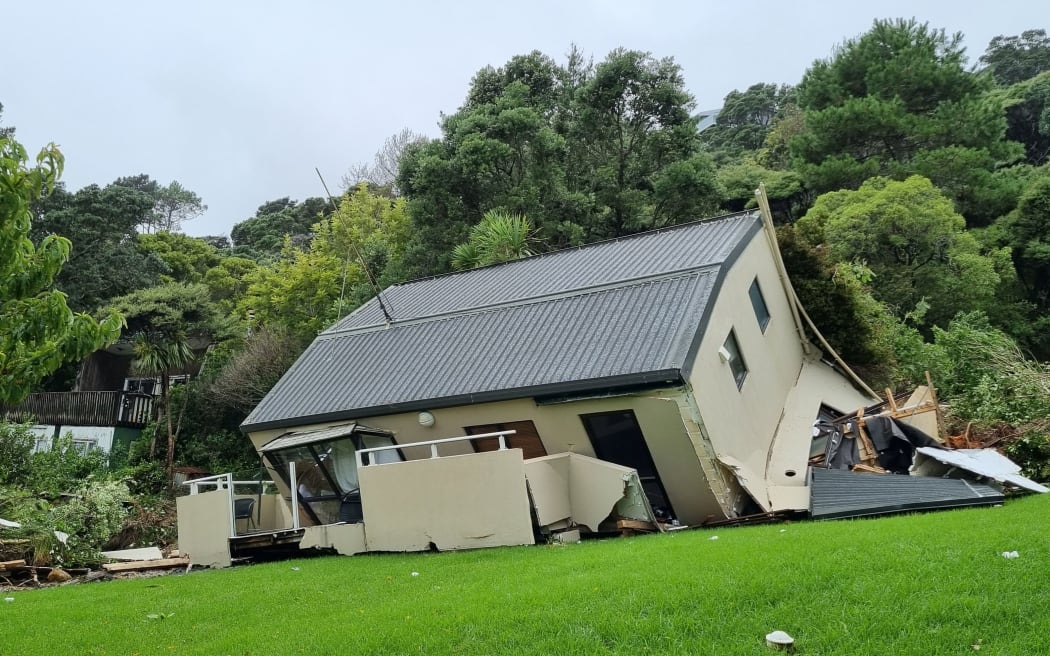
A house hit by a landslide in Muriwai.
Photo: RNZ / Tom Taylor
Severe weather battered the region overnight but heavy rain and strong winds have eased on Wednesday morning and all MetService warnings have been lifted.
In Muriwai, search and rescue teams were back on the scene where a firefighter has been missing since Monday night.
The firefighter was checking flooding in a property on Motutara Road when the property was hit by another house that collapsed.
A second firefighter, Craig Stevens, who was in the property at the time got out and was taken to hospital with critical injuries.
Fire and Emergency national USAR operations manager Craig Monrad said the search was suspended last night when it got dark.
He said it would resume today and crews were already on the scene making assessments.
Auckland Waitākere ward councillor Shane Henderson said search and rescue teams were doing their best to find the firefighter.
Henderson told Morning Report he was surprised that Piha and Muriwai were hit really hard from the cyclone.
He said he had heard many stories of near-misses and it “just shows the brutality of the cyclone and accompanying storm”.
Waikato including Coromandel Peninsula
Flooding, slips, storm surges and significant storm debris were reported in many areas around the region.
Power outages were also being reported by all network companies in the Waikato region.
Communities, such as Leamington in Waipa District, lost power early Tuesday morning and power is not expected to be restored until Wednesday evening.
The Lines Company and other network providers were posting estimated restoration times online.
However, if a suburb or its surrounding areas were affected by more than one outage, it was recommended that people plan to be without power until the latest time indicated.
Bay of Plenty
Many people in the region were still without power on Wednesday morning, and companies were warning it could be a while before they could safely make repairs.
MetService head of weather communications Lisa Murray said the region was relatively sheltered but could get more strong winds later.
“It’s really key that people heed the warnings right now … hunker down, it’ll hopefully pass over your region within the day.”
Taupō
Parts of the Napier-Taupō Road, or State Highway 5, were destroyed by cyclone Gabrielle’s fury on Tuesday.
Phone and electricity was cut off during much of the day and the council sent in a chopper to see how the rural community has fared.
Taupō District councillor Kylie Leonard said there were concerns for people’s welfare.
She said it would take some time to clear the many slips across roads linking Taupō and Hawke’s Bay.
* Read more: Live Cyclone Gabrielle updates: Trail of destruction, thousands evacuated
Gisborne
Limited power was back in parts of Gisborne on Wednesday morning after the Tairāwhiti region was cut off from the rest of the country by ex-tropical cyclone Gabrielle.
Communications with the region were still limited, and it could take weeks to get power and communications back up and running.
Residents in the region were also being asked to urgently conserve water after a break in the city’s main supply, somewhere between the dams and the treatment plant.
Gisborne Mayor Rehette Stoltz told Morning Report, via a satellite phone, that they would be delivering 22,000 Gisborne Herald prints on Wednesday to get messages across about the water situation.
“We only have enough water for a day or two and we need everyone to conserve water.”
She asked that everyone who received one in the region to “please read it”.
Stoltz said there were several breaks in the pipeline from the dams.
She warned people not to panic buy and that supermarkets would slowly open up today.
Taranaki
A red strong wind warning for Taranaki was lifted on Tuesday night after southerlies reached gale strength.
An orange heavy rain warning was also lifted at midnight.
Hawke’s Bay
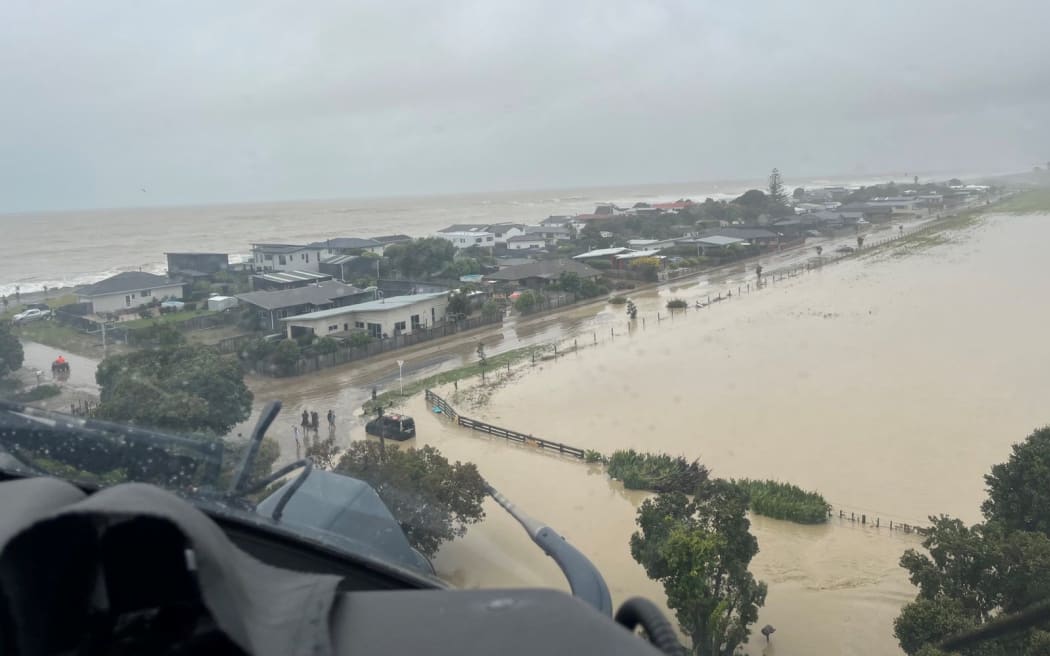
An NH90 helicopter and crew recover people from the rooftops of their homes in Esk Valley, Napier.
Photo: Supplied / NZDF
Wairoa District Council is communicating with the outside world via satellite.
An air force plane will fly over the town today to assess the damage.
A woman died in Putorino overnight, in northern Hawke’s Bay after a bank collapsed onto her home, Hawke’s Bay Civil Defence said.
Houses in the region were also underwater and roads washed out following Tuesday’s extraordinary amount of rain.
People were rescued from their roofs by helicopters and boats to escape rapidly rising floodwaters.
Civil Defence said they did not know how many people took shelter in evacuation centres, but the Hastings Sports Centre was nearing capacity last night.
Others spent the night stranded, waiting to be rescued from their flooded homes.
In Hastings and Napier, some people are still without power, and it could be days or weeks before power is returned to all customers.
Transpower said it would be challenging to get full power supply restored to the region.
It announced a national grid emergency yesterday after its Redclyffe substation was flooded.
Transpower chief executive Alison Andrew told Morning Report crews had not been able to get onto the site because of flooding.
She said a helicopter was coming up from Wellington on Wednesday to try and access the site.
Hastings Mayor Sandra Hazlehurst told Morning Report 250 people were rescued on Tuesday from various parts of the district.
She said Fire and Emergency and police were on the ground on Wednesday, getting to isolated communities and checking on people.
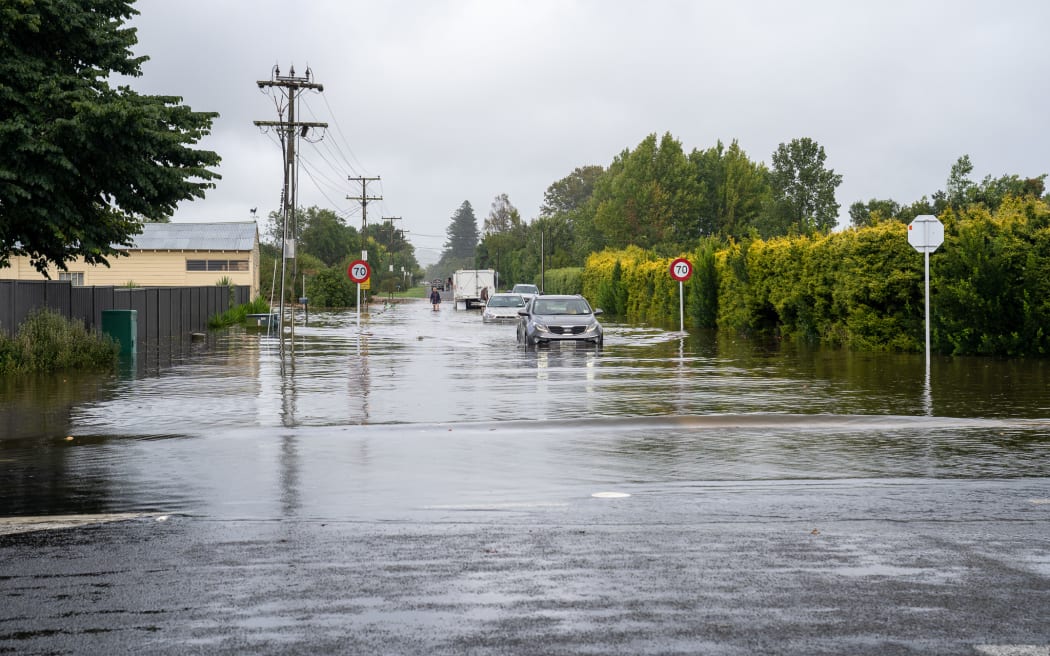
Flooded street in Hastings.
Photo: Hasting District Council
Napier Mayor Kirsten Wise said people in the city’s Te Awa Estate and surrounding suburbs should have grab bags ready for evacuation.
Wise said there were concerns the stopbank breach would cause more widespread flooding.
She said communications were still patchy in the region and radio was the best way to receive information from Civil Defence.
On the Art Deco Festival, Wise said with the current situation, she did not see how it would go ahead.
Wellington
Wellington City Council has asked residents to take care while travelling today as the weather may have caused slips and fallen trees.
The effects of Cyclone Gabrielle started hitting Wellington on Tuesday afternoon, bringing rain and wind.
Council media manager Richard Maclean said there had not been reports of weather-related damage overnight.
Meanwhile, Bluebridge and Interislander ferry services were cancelled until 2am on Wednesday and East by West Ferries cancelled Tuesday sailings.
The 6.15am and 7.30am Aratere sailings from Wellington were also cancelled due to the poor weather forecast and the 10.35am Aratere sailing was now freight only.
An orange strong wind warning for Wellington was lifted at midnight on Tuesday.
South Island
An orange heavy rain warning for eastern Marlborough was lifted at midnight as the cyclone continued to move slowly southeast.
National Emergency Management Agency advice:
- Put safety first. Don’t take any chances. Act quickly if you see rising water. Floods and flash floods can happen quickly. If you see rising water do not wait for official warnings. Head for higher ground and stay away from floodwater.
- Do not try to walk, play, swim, or drive in floodwater: even water just 15 centimetres deep can sweep you off your feet, and half a metre of water will carry away most vehicles.
- Throw away food and drinking water that has come into contact with floodwater as it is often contaminated and can make you sick.
- If you see a downed power line or damaged power equipment please stop, retreat and stay well clear.
- Stay at home if it is safe to do so and have an evacuation plan in case your home becomes unsafe to stay in.
- If you have evacuated, please stay where you are until you are given the all-clear to go home.
- People should stay up to date with the forecasts from MetService and continue to follow the advice of civil defence and emergency services.
- A National State of Emergency is in place for an initial period of seven days and applies to regions that have declared a local State of Emergency.

